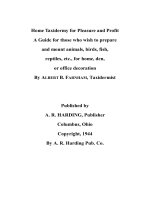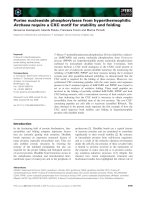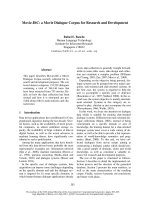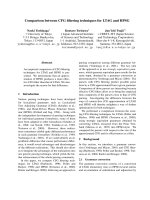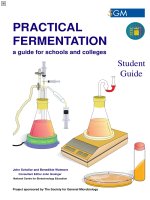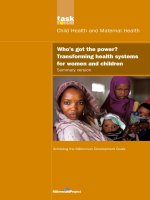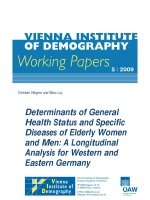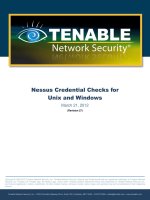Comprehensive Audit Analysis for Parks and Recreation pot
Bạn đang xem bản rút gọn của tài liệu. Xem và tải ngay bản đầy đủ của tài liệu tại đây (499.21 KB, 26 trang )
Comprehensive Audit Analysis for Parks and
Recreation
PREPARED BY:
JANUARY 2011
Parks and Recreation Audit – Draft Report
i
Acknowledgements
ii
Table of Contents
CHAPTER ONE - EXECUTIVE SUMMARY 1
1.1 INTRODUCTION 1
CHAPTER TWO - STAKEHOLDER INTERVIEWS 3
CHAPTER THREE - REVIEW OF ORGANIZATIONAL STRUCTURE AND ESTABLISHMENT
OF CORE ESSENTIAL SERVICES, IMPORTANT AND VALUE ADDED SERVICES 6
3.1 CORE SERVICES CRITERIA 6
3.2 FINANCIAL MANAGEMENT PRINCIPLES 7
CHAPTER FOUR - OPERATIONAL ASSESSMENT 9
4.1 THE FINANCIAL SITUATION OF THE DEPARTMENT 9
4.2 INTERNAL OPERATIONAL PROCES REVIEW 11
CHAPTER FIVE - BENCHMARK COMPARISONS 12
Appendix:
Appendix 1 – Core Services Identification
Appendix 2 – Funding and Revenue Strategies
Parks and Recreation Audit – Draft Report
1
CHAPTER ONE - EXECUTIVE SUMMARY
1.1 INTRODUCTION
The City of Grand Rapids Parks and Recreation Department contracted with PROS Consulting
to do a preliminary assessment of the Department to help the staff demonstrate to key City
leaders and the community how the Department compares with other cities of similar size
and best practice agencies in the Midwest area. The first phase of this assessment was to
determine what the Department is doing well, where they could operate in a more efficient
manner. This also included what operating strategies could be incorporated into daily
operations to create more operating revenue to off-set operational costs and to support
needed capital improvements for the agency.
Phase two work, if contracted, would include additional work with PROS Consulting that
would focus on how the Department can reposition itself with the key elected officials, City
management and the community. This work would focus on how the Department can be
viewed as an economic tool for the City versus viewed as a “spend” department with very
little return on investment back to the community. This work would also include how to
implement key recommendations provided in this preliminary assessment into daily
practices to move the Department forward in a positive manner to deliver on the outcomes
the key leadership of the City desire.
In advance of the first meeting, PROS Consulting provided the Department with a list of data
requests to review before the first interviews and meetings occurred in early January. The
data requests included the updated Master Plan for the Department, Park Maintenance
Division Operations Assessment prepared by staff, three years of past budgets, Urban Metro
Parks summary of comparisons, City Commission Policies, Outdoor Pool Report, Recreation
Rewards Program, and Organizational Charts.
Individual interviews were held with the Public Services Department Director, Parks
Director, Key Supervisor staff and the Friends of Grand Rapids Parks Director to review the
data provided to PROS Consulting. Discussion also centered on how and why the
Department got themselves in the position they are in beyond the lack of sufficient money
to manage the Department forward for the future.
PROS also was provided a tour of the system to review the key parks, pools, sports fields and
recreation facilities used for parks and recreation programs and services.
PROS Consulting recognize that the economy has played a considerable role in the decline of
the system over the last eight years, but the key to the future centers on the Department
achieving the outcomes the key leader’s desire for the Department. This will ensure the
Department can function and thrive in a positive sustainable manner for the future and
deliver on a high level of economic value and return on investment for the City and the
community.
The following information provided in this preliminary report is not intended to make the
Department, staff or the City look is if they do not care about parks and recreation facilities
and services. It is intended to demonstrate that great cities have great parks and recreation
systems and that these cities understand and value what parks and civic space can provide
to the community and its future to make the system appealing for residents and businesses
2
to want to invest in it, locate and stay in the Grand Rapids community. The Public Works
Director and Parks and Recreation Director are extremely committed and capable of
managing this Department forward for the future.
1.1.1 CORE VALUES OF THE DEPARTMENT
The Department core values are centered on the following:
Financial Sustainability
Efficiency
Customer Service
Protection of Park Infrastructure
Green Environmental Stewardship
Economic Development
Youth Development
Outcome Based Programs
Partnership Development
The Community’s core values as stated in the Updated Master Plan include:
Parks that Improve Neighborhood Quality of Life
Build Community Organizational Capacity and Pride
Volunteerism
Close to Home Recreation to Improve Health of Individuals
Attractive Residential Environments
Improvement in Property Values
Environmental Stewardship
The Department’s core values and the Community’s core values are closely aligned and in
the future the Department should combine these values into measureable outcomes that
can be demonstrated in parks, facilities and programs provided by the system.
The City of Grand Rapids has some extraordinary park properties that have served the
community well for a long period of years. The Department is at a crossroads and needs to
determine how they can manage the system forward and operating in a sustainable
manner. There are many opportunities available to them, but it requires a host of changes
and repositioning the system in the eyes of the City’s key leadership and the community as a
resource worth investing in to help the City achieve the outcomes desired by the
community.
Parks and Recreation Audit – Draft Report
3
CHAPTER TWO - STAKEHOLDER INTERVIEWS
PROS completed interviews with key City staff in the Public Works and Parks and Recreation
Departments as well as other Division’s throughout the City which routinely interface with
the Parks and Recreation Department in the provision of managing the municipal parks and
recreation services. The focus on these meetings was to gain insight into how staff sees the
services being provided. Ways to operate in a more sustainable manner. How much
tolerance for operational change exists? What are the key policies that need to be updated
or created such as pricing, earned income development, partnership management, reducing
entitlement of special interest groups and organizational design changes. The results of
these meetings are as follows:
The Department has experienced drastic cuts in the past eight years. Park
maintenance budgets have shrunk by 40% since 2002. Staffing levels are down 68%
compared to 2002 levels.
Since 2002, the tax spending per resident per year fell to $19.34 from $38.00. This is
far below the National Municipal levels of investment which is normally in the area
of $49 per resident based on NRPA Operational Study completed in 2009.
FY 11 direct Park maintenance expenses account for $11.22 per resident. Based on
585 acres maintained of the 1,209 acres in the system accounts for $3,793 per acre
which is approximately $2,256 an acre below similar Municipal park and recreation
agencies in the Midwest
Agencies revenues currently are 37% of the operating budget from grants and
program fees which is approximately 8% below Great Lakes/Midwest agencies.
The park acres, including the Grand Rapids Public Schools acreage per 1,000
residents is 7.88 acres per 1,000 which is low for typical Great Lakes and Midwest
cities which is usually 12-15 acres per 1,000 residents.
The Recreation budget for the Department including After-School Programs, Pools
and Recreation Programs is $3,083,987 of which is supported by a grant by 21st
Century Learning Centers of approximately 1.9 million dollars. The level invested for
recreation services is $15.60 per resident per year which is below the Great Lakes
Region and Midwest Cities of $21 dollars.
The Department has had no significant levels of capital improvement funding from
the General Operating Fund for the last five years and is currently in need of 30
million to repair what they already own which will only get worse unless these
assets are managed and taken care of for the future. As parks and recreation
facilities lose their value they will draw down neighborhood property values if not
maintained properly. The Department does not know the asset value of the park
system less the land value. Best practice park and recreation systems invest 3-4% of
their asset value protecting what they already own
The Department manages 51 buildings and lacks written maintenance standards
tied to frequency of tasks for buildings and park maintenance. The Department
doesn’t track cost per square feet to maintain facilities but does track cost per acre
to maintain parks
4
The golf course operation is breaking even as it applies to revenues and expenses
and has been losing rounds of play over the last six years which is following a
national trend. Golfers are still playing but not as often as they did in the late 90’s.
The golf course needs a business plan and program strategy to keep it focused on
generating revenue over and above their expenses
Current Master Plan standards need to be customized to 2011 demographic levels
of the city and recreation trends. The areas that need to be adjusted are tennis
court standards, soccer field standards, picnic shelters and should include new
standards, for gyms, indoor recreation center space, trails, dog parks, playgrounds,
fitness center space, skateboard park and spray grounds.
The Department does not have a business development section that would help the
Department to seek grants, develop new and improve existing partnerships,
incorporate new revenue sources, incorporate more marketing of programs and
services and develop a financial management strategy
No planning division exists within the Department to support improvements to
existing parks and recreation facilities for the existing and future needs of the
Department. This is being managed by the Parks and Recreation Director who is a
landscape architect but it makes it difficult to manage the system and do planning
Some policies need to be updated to reflect and support financial sustainability
which includes the pricing policy, partnership policy, volunteer policy, earned
income policy and acquisition policies
Design principles to support operational costs are not incorporated into the
Department’s approach to management
The Department does not have financial principles to manage the system forward
for the future and to guide decision making
The Department in the past has not tracked the economic value of the system to the
city and the return on investment they are making to the city general fund
Some performance measures are in place that the Department manages by
especially downtown parks which is funded by a special improvement district paid
for by the businesses downtown which provides a different example of park
maintenance than what is occurring in neighborhood parks and community parks.
The Department has written maintenance standards for downtown parks as well
which are established at a level two based on National Recreation and Parks
guidelines
The Department has Sustainability Plan Targets for park, recreation and programs
with established targets to achieve which is good to measure. These measures focus
on acquisition of playgrounds, decrease in time needed to repair park repairs,
increase in participation levels for after-school and playground participants,
increasing the access to gyms, increasing the people who participate in recreation
services, adding more connector trails, and increasing low impact design standards.
Additional consideration should be given to capacity management of parks,
recreation facilities and programs, customer satisfaction levels met, cost recovery
Parks and Recreation Audit – Draft Report
5
goals met, programs offered versus programs held, volunteer hours invested to
support existing operations, and partnership equity
The Department does not have true cost of service data available to them to
determine existing cost recovery levels and unit costs. Having this information
would help them to achieve the right price point for services and how to maximize
their operating dollars. Currently the Department has a good understanding of
direct costs but not in-direct costs and in review of their prices for services appears
to be undervalued in several categories. If and when the Department does track
cost of services it will help them to achieve the right cost recovery level for each
program and facility
No crime statistics are tracked near parks where they are closed or recreation
facilities that are closed to demonstrate the impact on crime
The Department has a good number of partnerships in place. Equity levels of these
partnership investments is not tracked or leveraged for future grants
The Department has a good adopt a park policy and this should continue. The
Friends of Grand Rapids Parks has done an incredible job of helping the Department
to support development of new playgrounds, supporting park maintenance and
assisting in creating new park related amenities. This is best practices and needs to
continue for the future
6
CHAPTER THREE - REVIEW OF ORGANIZATIONAL STRUCTURE AND
ESTABLISHMENT OF CORE ESSENTIAL SERVICES, IMPORTANT AND VALUE
ADDED SERVICES
The Department had not established their core essential, important and value added/visitor
based services but did work through this after PROS Consulting left the City (see attached
Appendix 1) in early January. The importance of developing this focus is centered on having
a clear understanding of the Department’s approach to managing these services for the
future and how to price these services to the community and specific users.
The following criterion determines, core essential, important and value added services.
3.1 CORE SERVICES CRITERIA
The following Core Services criterion was presented to staff in the workshop and was agreed
to be used to test existing services provided by the Department.
3.1.1 CORE SERVICES – “ESSENTIAL”
Definition of “Essential Services”
o Core “Essential” services are those programs, services and facilities the
Department must provide and/or are essential in order to capably govern
the Agency. The failure to provide a core service at an adequate level would
result in a significant negative consequence relative to the City’s health &
safety and economic & community vitality
Criteria
o The Department is mandated by law, by the Charter or is contractually
obligated by agreement to provide the service
o The service is essential to protecting and supporting the public’s health and
safety
o The service protects and maintains valuable Department assets and
infrastructure
o The City’s residents, businesses customers and partners would generally
and reasonably expect and support the Department in providing the service,
and that service is one that cannot or should not be provided by the private
sector, and provides a sound investment of public funds
3.1.2 CORE SERVICES – “IMPORTANT”
Definition of “Important” Services
o Core “Important” services are those programs, services and facilities the
Department should provide, and are important to governing the Agency and
effectively serving our residents, businesses, customers and partners.
Providing “Important” services expands or enhances our ability to provide
and sustain the Department’s core services, health & safety, and economic
& community vitality
Parks and Recreation Audit – Draft Report
7
Criteria
o Service provides, expands, enhances or supports identified core services
o Services are broadly supported and utilized by the community, and are
considered an appropriate, important, and valuable public good. Public
support may be conditional upon the manner by which the service is paid
for or funded
o Service generates income or revenue that offsets some or all of its operating
cost and/or is deemed to provide an economic, social or environmental
outcome or result within the community
3.1.3 CORE SERVICES – “VISITOR SUPPORTED SERVICES”
Definition of “Visitor Supported” Services
o Visitor Supported services are programs, services and facilities that the
Department may provide when additional funding or revenue exists to
offset the cost of providing those services. Visitor Supported services
provide added value to our residents, businesses, customers and partners
above and beyond what is required or expected of a municipal agency
Criteria
o Service expands, enhances or supports Core Services, Important Services,
and the quality of life of the community
o Services are supported and well utilized by the community, and provide an
appropriate and valuable public benefit
o Service generates income or funding from sponsorships, grants, user fees or
other sources that offsets some or all of its cost and/or provides a
meaningful economic, social or environmental benefit to the community
The Department has worked through these criteria in their work session as outlined in
Appendix (1) and will now begin the process to establish a management approach and cost
recovery goal for each core service function and revenue producing service. The
Department is capable of managing to these management changes given the opportunity to
do so based on conversations with staff in work sessions leading up to this report.
3.2 FINANCIAL MANAGEMENT PRINCIPLES
The Financial Management Principles provide the Department with key financial strategies
that will guide their thinking in the future. The increasing significance of the Department
becoming more self-supporting makes the principles even more relevant for financial
planning. The goal is to become 60% self-supporting in the next three years to support
operational costs of the Department and to help manage the Department forward including
making the necessary capital improvements that have been neglected for some time. The
Department will need to incorporate updated pricing, partnership, and earned income
polices for the future to achieve this goal.
8
The staff has a fiduciary responsibility for achieving financial sustainability to move the
Department forward in the future and protect the resources in the system. The following
Financial Management Principles will form the basis for policy decisions affecting this goal.
These principles should be considered.
The financial planning for facility and program services will be consistent with the
goals and objectives of the City Commission and support the initiatives and
strategies as reflected in the Department’s approved financial plans. Likewise, the
Department’s goals and objectives which affect the revenue funding sources and
will be consistent with revenue availability and financial projections. A specific
Revenue Fund will be established to put revenues into to support operational costs
and re-appropriated at the end of each year to support the following year’s
operational budget.
The Department will use a minimum of a three-year Financial Management Plan for
establishing and implementing revenue funding sources with out-year projections
up to ten years. The Department’s Financial Plan will be updated at least annually
and will be used as the basis for the development of budgets and revenue/fee
schedules.
The Department’s budget will be developed as a program based budget, ensuring
the highest possible accuracy of revenue projections and the review and evaluation
of budget expenditure requirements. Annual budget plan submittals will meet all
the City of Grand Rapids budget requirements. All efforts will be made to optimize
productivity for improved service delivery at the lowest possible cost levels to the
budget.
The annual operating budget will project and produce a positive cash balance for
each fiscal year. A cost recovery ratio for the budget-planning year will be
developed and integrated into the financial management plan for all programs and
revenue producing facilities.
Management of the revenue funds for budgeting purposes will be at cost/profit
center level so that each program and function is reviewed annually both for
revenue projections and expenditure needs. Where possible, each cost center will
produce net revenue and keep expenditures to the lowest possible levels.
A Managed Reserve will be maintained at a sufficient level to allow for yearly cash
flow requirements and to provide for financing unforeseen needs of an emergency
nature. The cash flow portion of the reserve will be a minimum of three percent of
the approved annual expenditure budget. The emergency portion of the reserve will
be at least two percent of the approved annual expenditure budget of the Revenue
Fund. The Managed Reserve shall be adjusted annually at the time the budget is
adopted.
Net revenue generated from the fiscal year, above that needed to sustain the
reserves will be committed as approved by City Commission. Funding priority will be
given to the repair and renovation requirements of the Revenue Fund’s facilities and
for support of revenue generating programs. At the City Manager’s direction, all, or
a portion of the net revenue, will be appropriated annually to the Department’s
Parks and Recreation Audit – Draft Report
9
Park Capital Improvement Fund for future needs associated with the repair and
renovation of Revenue Fund facilities and programs. Funding requirements will be
reviewed and updated annually.
All revenue producing facilities will develop an annual business plan and will
establish direct and indirect costs associated with the services provided.
Design financial principles will be include financial costs and operational impacts for
any redesign of a park or a new design of a park
New Recreation Facilities that will be coming on line will include a feasibility study
prior to construction beginning to determine the cost to operate and revenues that
can be gained from programs provided to determine the cost recovery level needed
to support financial sustainability
These Financial Management Principles will be reviewed by the City Commission
annually to help the Department achieve financial sustainability.
CHAPTER FOUR - OPERATIONAL ASSESSMENT
4.1 THE FINANCIAL SITUATION OF THE DEPARTMENT
The financial situation of the Department indicates a department that has been starved for
some time. The Department has had eight years of budget decline and has lost 40% of its
budget from 2002 levels. Half of the city’s tax dollar support for Parks in 2002 is gone.
Budget dollars to maintain parks is half what it was in 2002 and yet the Department is still
surviving although not very effectively for such a beautiful set of park settings. The real
point that needs to be understood is that the Department has been neglecting capital
improvements to keep the parks and recreation facilities in a state of condition that
supports a desired image of the community. Imagine not investing in a $200,000 house for
ten years and expecting it to function or increase in value let alone what the parks get in use
versus a house.
The Parks System needs to be totally repositioned for the future for it to survive and thrive
in the next ten years. The Department needs to re-think how to become financial
sustainable which requires a different management model. The following recommendations
should be considered for the Department to help manage itself forward if politically feasible.
Consider development of a Park Authority or Park Commission to remove itself from
the general fund budget. The Park Authority or Park Commission could be combined
with the County Parks and Recreation system and other city or township systems
Demonstrate the Department’s economic value to the city so the Key leaders can
see the Department not as a spend department but as an earned department and as
an economic tool to attract a knowledgeable workforce or for economic purposes.
The Department needs to track the property loss level of parks that have not been
maintained well versus the parks that have been maintained well to demonstrate
that well maintained parks create higher property values and reduce crime in
neighborhoods
10
Eliminate, sell, or lease park property to reduce costs, or increase revenue
opportunities. The Department has prepared a list of park properties that can be
leased for recreation purposes that can return a level of investment to the
Department through annual lease payments
Develop new earned income opportunities that are available but not used by the
Department. (see appendix 2) for a list of options
Seek enhancement to existing polices to support the cost recovery goal of 60%. This
would include an updated pricing policy, partnership policy, earned income policy,
volunteer policy, and sponsorship policy
Create or enhance revenue producing facilities to support operational costs and
capital costs
Develop recreation facilities and amenities that attract a knowledgeable work force
and develop recreation services centered on supporting a healthy work force and
community
Continue efforts to work with the Friends of Grand Rapids Parks to develop funding
options and work programs to help maintain and support the system through adopt
a park type of programs and capital improvements in parks
Eliminate any service, amenity or park that that is not achieving the outcomes
desired or transfer the park, amenity or service to another agency to manage it for
the City
Develop business plans for each type of core service or major attraction
Price services based on cost of service assessment, a cost recovery goal and inform
users of why the price and cost recovery goal
Develop as much partnership equity in the each partnership they have established
or will establish for the future
Develop feasibility studies for any new program, park or service to determine the
costs and rather the Department can afford it
Learn to say “no” gracefully to groups looking for something from the Department
Develop a sponsorship program in parks to sponsor parks, fields, playgrounds, trails,
art, recreation facilities and events
Develop a business development office within the Department to help track grants,
develop sponsorships, price services, market the parks and facilities, and manage
the partnerships
Determine the true cost to provide any service through an activity based costing
system
Develop an asset management plan and capital improvement program with capital
improvement criteria that determines the cost benefit of any capital improvement
to the system
Develop three new dedicated funding sources annually to support the Department
Parks and Recreation Audit – Draft Report
11
Move all visitor supported services to cover their full direct and indirect costs
4.2 INTERNAL OPERATIONAL PROCES REVIEW
The internal Operational Review is being developed from the Data that was sent to PROS
prior to the interviews and on-site visits to Grand Rapids. The following are
recommendations for staff to consider.
The organizational design of the Park and Recreation Department should
incorporate so that all recreation functions become one division that includes golf.
The Department should consider one division for park maintenance versus a
North/South division. The Department needs to establish a Business Development
division to go after grants, enhance and seek new partnerships, develop new earned
income opportunities, improve on marketing and pricing the system, and
development of cost of service data
The Department needs to have access to a planning division to enhance and
improve on existing parks for the future
Maintenance standards need to be developed with unit costs for all parks and
recreation facilities including buildings the Department takes care of for the city
Update the polices for pricing, partnerships, volunteerism, earned income,
sponsorship, advertising and working with schools
Add additional performance measures to the work that is being done currently to
include capacity management, programs offered versus programs held, standards
met in programs, parks and facilities, volunteer hours worked in parks to be used for
grant matches, new participants to the programs, age segments served, cost
recovery goals met, customer satisfaction levels met, partnership equity levels met,
and capital investments met to enhance value to the neighborhood property values
The organizational culture needs to adopt a financial sustainability mindset and
determine the following for each program or service:
o For whom is the service being provided for?
o For what purpose?
o For what benefit?
o For what costs and is it worth the return on investment
Train staff on business modeling, cost of service management, effective pricing of
services, marketing, managing to outcomes, and tracking performance measures to
determine efficiency and revenue production
Continue to leverage the Friends of Grand Rapids Parks to help deliver services and
capital improvements to the city parks
Develop work plans for all staff on a weekly and monthly basis with financial
outcomes and performance measures tracked
12
Continue to cross train staff in all areas of the system to maximize the value of staff.
Develop a plan to incorporate the right person in the right job for the right pay for
the right frequency using the right equipment
Supplement volunteers hours into the budget process to support staff in park
maintenance. Train in all areas of the work that needs to be done
Continue to have managed competition for work that is required to achieve the
maintenance standards desired in parks at the least cost to the system
Determine cost recovery levels for all core programs, recreation facilities, golf,
services, reservations, permits, rentals in the park system and Increase program
offerings in parks, pools, golf, game fields, special events, youth programs, and
young adults to increase their value and support for the park and recreation system
while recovering a higher level of cost recovery for the Department as a whole
Achieve 60% of cost recovery for the Department by the end of 2013
Develop a junior volunteer program for youth and college students in parks to help
support the cities needs
Continue to provide the Recreation REAPS Rewards program in the city
Develop or lease more indoor recreation space for wellness and fitness, youth
sports, adult sports, and general life skill classes
Track the economic value of the system and present annually to city council and
business leaders of what parks do for the community
The organizational chart should consider combining divisions of recreation and golf
into one division and all park maintenance into one division versus a north and
south district
CHAPTER FIVE - BENCHMARK COMPARISONS
The Department benchmark comparisons are based on the National Recreation and Parks
Operational Study completed in 2009.
Acres per 1,000 population including GRPS acreage; Grand Rapids 7.88 acres,
Nationally 12-15 acres for Great Lakes and Midwest
Budget Per Capita; Grand Rapids $19.34, Nationally $49.00
Acre cost per maintained acre; Grand Rapids $3,792, Nationally $6,049
FTE maintenance staff per acre maintained; Grand Rapids 21.92 acres, Nationally
14.1. PROS divided 585 maintained acres by 26.69 FTE’s doing park maintenance
and came up with 21.92 acres maintained per FTE.
Capital Improvement invested yearly; Grand Rapids; minor capital and new
KaBOOM! playgrounds , Nationally 3% of total fixed asset value less land
Cost recovery levels for operating budget: Grand Rapids, 37%, Nationally 45%
Community involvement in programs: Grand Rapids, 35%, Nationally 40%
Parks and Recreation Audit – Draft Report
13
Percent of Community that uses parks; Grand Rapids, the Department has not
surveyed for this information, Nationally 76%
Recreation spending per capita; Grand Rapids, $15.60, Nationally $21
Miles of trails; Grand Rapids, 13.85 miles or .07 per 1,000, Nationally .4 miles per
1,000 people. Using the population of Grand Rapids of 197,800 this means
approximately 80 miles would be necessary to meet the national standard
Recreation Center per population; Nationally, 1 to 23,500 people which means
approximately 8.4. The city has 3 gyms; one at Garfield Park, Paul I. Phillips Center
and Roosevelt Parks. It would be beneficial for the department to have their own
recreation centers. This would position them better to meet the needs of the
residents and to increase the opportunity to generate revenue.
Playgrounds per 1,000 population; Grand Rapids 32, Nationally, 1 to 3,500 which
means the City should have approximately 57.
Agency Revenues per capita; Grand Rapids, $14.11, Nationally, $24
14
CHAPTER SIX - APPENDIX
6.1 APPENDIX 1: CORE SERVICE IDENTIFICATIN
The following listing is the core essential services (red), important services (blue) and visitor
supported services
(green)
Parks Maintenance
Turf Maintenance
Athletic Field Maintenance
Water Management
Playground Safety
Urban Forestry
Tree Maintenance
Risk / Liability
Long Range Open Space Planning
Open Space / Preserve Maintenance
Nature Preserve Enhancement
Park Planning and Design
Trail Development
Construction
City-Wide Planning
Land Management
SERVICE TYPE
Parks and Recreation Audit – Draft Report
15
Facility Operations & Rentals
Community Centers
Sport Complexes
Facility, Park & Field Rental
Pool Maintenance
Senior Center
Tennis Center
Program management
Aquatics & Public Swim
Health & Fitness
Youth Sports
Adult sports
Youth & Teen Development
Youth Classes
Adult Classes & Programs
Senior Programs
Special Events
Community Events
Cultural Programs
Environmental Education
Tennis
Facility Management
Program Management
SERVICE TYPE
16
Policies & Procedures
Pricing
Earned Income
Sustainability
Sponsorship
Partnership
Budget Development (Management)
Coordination
Marketing
Website
Social Network
Program Guide
Business Management
Coordination of All Processes
Performance Management
Activity Based Costing
Cost Center Management
Strategic Planning
Partnerships
General Plan Compliance
Planning Coordination
Volunteer Coordination
Adopt -a-Park
Program Volunteers
Park Volunteers
Contract Management
Commission Management
Parks and Recreation Board
Seniors Advisory Committee
Sports Council
Youth Task Force
City Commission
Capital Management
Public/Public
Public/Not-for-Profit
Public/Private
Joint Use Agreement
Pool Compliance
Information Technology
Rec Trac
Asset Management
Human Resource Management
Staffing
Training
Administration
SERVICE TYPE
Parks and Recreation Audit – Draft Report
17
6.2 APPENDIX 2: FUNDING STRATEGIES
Park and Recreation systems across the United States today have learned to develop a clear
understanding of how to manage revenue options to support parks and recreation services
in a municipality based on the limited availability of tax dollars. Park and Recreation
systems no longer rely on taxes as their sole revenue option but have developed new
sources of revenue options to help support capital and operational needs.
A growing number of municipalities have developed policies on pricing of services, cost
recovery rates and partnership agreements for programs and facilities provided to the
community. They also have developed strong partnerships that are fair and equitable in the
delivery of services based on whom receives the service, for what purpose, for what benefit
and for what costs. In addition, agencies have learned to use parks and recreation facilities,
amenities, programs and events to create economic development as it applies to keeping
property values high around parks and along trails through increased maintenance, adding
sports facilities and events to drive tournaments into the region that create hotel room
nights and increase expenditures in restaurants and retail areas. They have learned to
recognize that people will drive into their community for good recreation facilities such as
sports complexes, pools, and for special events if presented correctly and are well managed.
In the Department, these policies and management practices are not all in place and should
be considered for the future. PROS is outlining several options for the Department to
consider as outlined below. In any event PROS feels that some if not all of these sources
should be considered as an option to support the capital and operational needs of the
Department as outlined.
6.2.1 FUNDING SOURCES FOR CAPITAL IMPROVEMENT DOLLARS AND
OPERATIONS
The following financial options outline opportunities for the Department to consider in
supporting capital improvements as well as operational costs associated with managing the
system for the future. Many of these funding sources may not be allowed or have never
been used and should be pursued through legislative means should the City see the value in
pursuing these funding sources.
General Obligation Bond: A general obligation bond is a municipal bond secured by a taxing
authority such as the City of Grand Rapids to improve public assets that benefits the
municipal agency involved that oversee the parks and recreation facilities. The City of Grand
Rapids has not done a General Obligation Bond for parks and recreation facilities for a very
long time and based on the values that the community holds for parks and recreation
facilities it should be considered to promote economic sustainability and livability in Grand
Rapids.
General Obligation Bonds should be considered for general park and recreation facility
projects because there is very little operational revenues associated with these parks to
draw from and these park improvements are in need of upgrades and renovations limiting
the uses of other revenue sources. These parks help frame the City’s image and benefit a
wide age segment of users and updating these parks will benefit the community as a whole
and stabilize these neighborhoods. Over the last 10 years across the United States over 90%
18
of park and recreation bond issues have passed in cities when offered to the community to
vote to support the community needs for parks and recreation. This is according to Trust for
Public Land research.
Governmental Funding Programs: A variety of funding sources are available from federal
and state government for park-related projects. For example, the Land and Water
Conservation Fund funding program has been reinstated for 2011 levels at 150 million and
can provide capital funds to state and local governments to acquire, develop, and improve
outdoor recreation areas. Federal Community Development Block Grant (CDBG) funds are
used to support open space related improvements including redevelopment and new
development of parks and recreation facilities. Transportation Enhancement Funds available
through SAFETELU, the current federal transportation bill, can be used for trail and related
green space development, AmeriCorps Grants can be used to fund support for park
maintenance.
SAFETULU funds as well as Safe Routes To School Funds should be pursued for the trail
improvements outlined in the plan. SAFETULU monies require a 20% match by the City and
Safe Routes to School Funds require no match by the City.
CDBG (Community Development Block Grants) funds are used by many cities to enhance
parks. These funds should be used to support the re-development of major facilities based
on its location in the City and what it will do to enhance the neighborhood and schools
surrounding the park which is the purpose for CDBG monies
AmeriCorps Grants should be pursued by the Parks Division to support park maintenance
and cleanup of drainage areas where trails are located and small neighborhood parks in the
City.
If applying for these grants is an issue, the Department staff should seek out a grant writer
to write application.
Park Impact Fees: The City has not implemented park impact fees. As the current
deficiencies in park and trail standards are met, these funds should help support the
Department’s capital improvements. Impact fee generally provide some capital funds but
rarely are they sufficient to provide full funding of large projects.
Internal Park Improvement Fund: This funding source is created from a percentage of the
overall park admissions to attractions such as sport complexes or special events in the park
and would allow a percentage usually in the 3-5% of gross revenues to be dedicated to the
park for existing and future capital improvements. This funding source is used for sports
complexes, aquatic parks, campgrounds, and fee based parks. This type of user fee generally
does not require voter approval but is set up in a dedicated fund to support the existing
attraction for future maintenance and improvements.
Tax Allocation or Tax Increment District: Commonly used for financing redevelopment
projects. A Tax Allocation District (TAD) involves the issuance of tax-exempt bonds to pay
front-end infrastructure and eligible development costs in partnership with private
developers. As redevelopment occurs in the City, the “tax increment” resulting from
redevelopment projects is used to retire the debt issued to fund the eligible redevelopment
costs. The public portion of the redevelopment project funds itself using the additional taxes
generated by the project. TADs can be used to fund park improvements and development as
Parks and Recreation Audit – Draft Report
19
an essential infrastructure cost. These funds would work well in the downtown
redevelopment and in trail development the City has proposed. The city of Valparaiso
Indiana has used this funding source extensively for their redevelopment of the downtown
area and has made a huge impact on the image and impact to parks and business in the
downtown area.
Cash-in-Lieu of Open Space Requirement: Ordinances requiring the dedication of open
space within developments to meet the park and recreation needs of the new residents
often have provisions allowing cash contribution to substitute for the land requirement.
Facility Authority: A Facility Authority is sometimes used by park and recreation agencies to
improve a specific park or develop a specific improvement such as a stadium, large
recreation center, large aquatic center, or sports venue for competitive events. Repayment
of bonds to fund the project usually comes from a sales tax in the form of food and
beverage. A facility Authority could oversee improvements for the large facilities; such as,
aquatic center and sports fields as appropriate. The City could seek out a private developer
to design build the facility for the City with the City paying back these costs over a 20 year
period. The Facility Authority would include representation from the schools, the City and
private developers.
Utility Lease Fee: Utility lease fees have been used to support parks in the form of utility
companies supporting a park from utility easements, storm water runoff and paying for
development rights below the ground. This funding source is derived from fees on property
owners based on measures such as the amount of impervious surfacing as well as fees from
utility companies having access through the park. It is used by many cities to acquire and
develop greenways and other open space resources that provide improvements in the park
or development of trails. Improvements can include trails, drainage areas, and retention
ponds that serve multiple purposes such as recreation, environmental protection, and storm
water management. This could be a source for the utilities to make a contribution to
support the parks and trails in the future.
Transient Occupancy Tax: This funding source is used by many cities to fund improvements
to parks from hotels that benefit from the parks and Transient Occupancy Taxes are typically
set at 3-5% on the value of a hotel room and a 1% sales tax that can be dedicated for park
and recreation improvement purposes. Because of the value that parks could provide in the
way of events, sports, entertainment and cultural events hotels in the area that benefit
could be set up with a portion of their occupancy funds going to support park and recreation
related improvements. This funding source should be implemented progressively as the City
increases the number of events it sponsors. Tracking the economic value back to the hotels
is important to build trust with the Hotel business community. This funding source is used
very well in Genesee County Parks.
Food and Beverage Tax: This tax is currently used by many cities. In many cities they seek a
¼ or 1/8 cent sales tax on retail food and beverages to support parks and recreation needs
in their community and can raise a substantial amount of revenue that can be used to pay
for a bond for needed improvements. These dollars can come from the local community as
well as visitors to the City to help pay for a bond to finance future park and recreation
related improvements. Food and Beverage Taxes are very well accepted in most Midwest
communities.
20
Capital Improvement Fee: A capital improvement fee can be added to an admission fee to a
recreation facility or park attraction to help pay back the cost of developing the facility or
attraction. This fee is usually applied to golf courses, aquatic facilities, recreation centers,
stadiums, amphitheaters, and special use facilities such as sports complexes. The funds
generated can be used either to pay back the cost of the capital improvement on a revenue
bond that was used to develop the facility. Capital improvement fees normally are $5 per
person for playing on the improved site or can be collected as a parking fee.
Lease Back: Lease backs are a source of capital funding in which a private sector entity such
as a development company buys the land or leases the park land and develops a facility such
as a park, recreation attraction, recreation center, pool, or sports complex; and leases the
facility back to the municipality to pay off the capital costs over a 30 to 40 year period. This
approach takes advantage of the efficiencies of private sector development while relieving
the burden on the municipality to raise upfront capital funds. This funding source is typically
used for recreation and aquatic type facilities, stadiums, civic buildings, and fire stations.
Real Estate Transfer Tax: Real Estate Transfer Tax provides a 1% tax on the buyer of real
estate property that exchanges hands and is used primarily in built-out communities to
support maintaining parks and civic space so the neighborhoods are kept at a higher level.
6.2.2 FUNDING SOURCES FOR OPERATIONAL DOLLARS
Land Leases/Concessions: Land leases and concessions are public/private partnerships in
which the municipality provides land or space for private commercial operations that
enhance the park and recreational experience in exchange for payments to help reduce
operating costs. They can range from vending machines to food service operations to full
management of recreation attractions.
Admission to the Park: Many park and recreation systems in the United States have
admission fees on a per car, per bike and per person basis to access a park that can be used
to help support operational costs. Car costs range from $3 to $5 a car and $2 dollars a
bicycle or $2 dollars a person. As a community this may not be appropriate for Grand Rapids
at the present time but may be considered in the future. This fee may be useful for large
events and festivals that have the capability to be set up as a fee based park at least on
weekends.
Parking Fee: Many parks that do not charge an admission fee will charge a parking fee.
Parking rates range from $3 to $4 dollars a day. This funding source could work for helping
to support special events, festivals and tournaments.
User Fees: User fees are fees paid by a user of recreational facilities or programs to offset
the costs of services provided by the Department in operating a park, a recreation facility or
in delivering programs. In Grand Rapids recreation programs are highly undervalued. A
perception of “value” needs to be instilled in the community for what benefits the City is
providing to the user. Future fees could be charged by the Department based on cost
recovery goals for the parks and or core recreation services based on the level of exclusivity
the user receives compared to the general taxpayer. PROS would highly recommend that
user fees for programs be charged to create value and operational revenue for the Parks
and Recreation Department. If the Department feels that they cannot move forward on user
fees to help offset operational costs then they might consider contracting with an area non-
Parks and Recreation Audit – Draft Report
21
profit; such as a YMCA, to manage future recreation facilities and programs. The
Department then could take the dollars they have invested in staff and in subsidized
recreation facilities and use those dollars to support an improvement bond to make
improvements to existing parks and or build new parks and recreation facilities with the
existing dollars in their operational budgets. This would change the role of the Department
to a facility provider versus a program operator. The cost savings from not having recreation
staff and not subsiding pools and other recreation facilities could be $300,000 a year that
then could be used for park and recreation related improvements.
Corporate Naming Rights: In this arrangement, corporations invest in the right to name an
event, facility, or product within a park in exchange for an annual fee, typically over a ten-
year period. The cost of the naming right is based on the impression points the facility or
event will receive from the newspapers, TV, websites, and visitors or users to the park.
Naming rights for park and recreation facilities are typically attached to sports complexes,
amphitheaters, recreation centers, aquatic facilities, stadiums, and events. Naming rights
are a good use of outside revenue for parks, recreation facilities or special attractions in the
City.
Corporate Sponsorships: Corporations can also underwrite a portion or all of the cost of an
event, program, or activity based on their name being associated with the service.
Sponsorships typically are title sponsors, presenting sponsors, associate sponsors, product
sponsors, or in-kind sponsors. Many agencies seek corporate support for these types of
activities.
Advertising sales on sports complexes, scoreboards, gym floors, trash cans, playgrounds, in
locker rooms, at dog parks, along trails, flower pots, and as part of special events held in the
City to help support operational costs have been an acceptable practice in parks and
recreation systems for a long time and should be considered for the Department to support
operational costs.
Maintenance Endowment Fund: This is a fund dedicated exclusively for a park’s
maintenance, funded by a percentage of user fees from programs, events, and rentals.
Park Revolving Fund: This is a dedicated fund to be used for park purposes only that is
replenished on an ongoing basis from various funding sources such as grants, sponsorships,
advertising, program user fees and rental fees within the park. The Department could
establish a revolving fund supported by one or more funding sources identified in this
section.
Permit Fees: This fee could be incorporated for exclusive reservation for picnic shelters,
sports fields, special events provided by the Department, and competition tournaments held
in the city by other organizations. Permit fees include a base fee for all direct and indirect
costs for the city to provide the space on an exclusive basis plus a percentage of the gross
for major special events and tournaments held on City owned permitted facilities. These
dollars could be applied to the Park Revolving Fund to help support park improvements.
6.2.3 PRIVATE FUNDING SOURCES
Business/Citizen Donations: Individual donations from corporations and citizens can be
sought to support specific improvements and amenities. The Department might consider
